Veteran’s Testimony – Harold F. O’Keefe 1st Air Force Clearing Station, 39th Field Hospital
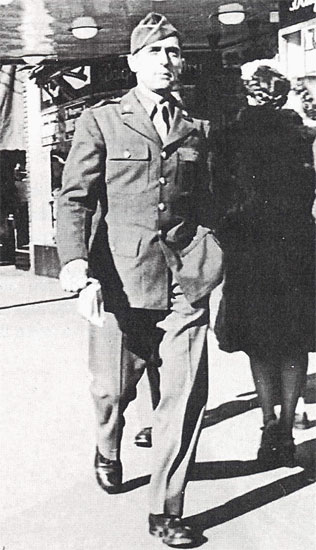
Private Harold F. O’Keefe strolling around downtown Columbia, S. Carolina. Picture taken in January 1943, when stationed at Ft. Jackson (ITC), S.C.
Introduction:
Harold Frederick O’Keefe was born in Paterson, New Jersey, on 18 February 1916, to Thomas and Louise O’Keefe. Harold had 4 sisters, Laura, Ruth, Muriel and Catherine. The O’Keefes were divorced in 1920, and after Louise married Ben Estrow, the family moved to New York City. As stepfather Ben was an electrical stagehand who worked in many of the Broadway Theaters, he did eventually get Harold into the Stage Employees’ Union, where the young man received some of his electrical training. It was one of the many jobs that he held before joining the Army, eventually serving with the Army Air Forces.
During 1936, Harold was in the Merchant Marine. In 1937, he obtained a Chauffeur’s License in New York City authorizing him to operate gasoline-powered automobiles. In 1939, Harold met a certain Frances J. Wagenhofer and ended up marrying her on 12 October 1940, in Passaic, New Jersey.
Harold meanwhile worked as a mechanic for an Automobile Sales & Services Company in New Jersey, and later became an employee with an Aeronautical Corporation located in the same State. As per the Selective and Training Service Act of 1940, he duly registered for the draft and got classified as a Class 3-A candidate (3-A > registrant deferred because of hardship to dependents, but available and fit for general military service).
Frederick William O’Keefe was born on 29 August 1942, his Father, Private Harold F. O’Keefe, ASN 32596985, was inducted on 4 December 1942, in Rutherford, New Jersey. Harold’s son was in fact only 3 months old when his Dad was inducted!
Assignment:
Private Harold F. O’Keefe became one of the 3,033,361 men to be inducted into the Army of the United States during 1942. Although registered under the Second Service Command, he was shipped to Ft. Jackson, Columbia, South Carolina for Basic Training on 21 February 1944 (Ft. Jackson was an Infantry Training Center, spread over 58,653 acres, with a training capacity for 5,907 Officers and 72,817 Enlisted personnel under jurisdiction of the Fourth Service Command). A few months later, his wife, Frances, joined her husband at Ft. Jackson much against her parents’ advice. But off she went with her first baby and all her bags. She would become pregnant with her second son, Harold John, who was born on 31 July 1944 (just 6 weeks before Harold F. O’Keefe was killed overseas).
Having gone through Basic Training, Private O’Keefe, was initially assigned to an Infantry unit as a Military Policeman. There are unfortunately no files to indicate the reasons for his transfer to the 39th Field Hospital, but he sure got assigned to First Platoon, 39th Field Hospital sometime in the course of 1943 (after May).
(Infantry units which followed training at Ft. Jackson, S.C., during World War 2 included: 4th Infantry – 6th Infantry – 8th Infantry – 26th Infantry – 30th Infantry – 77th Infantry – 87th Infantry – 100th Infantry and 106th Infantry Divisions).
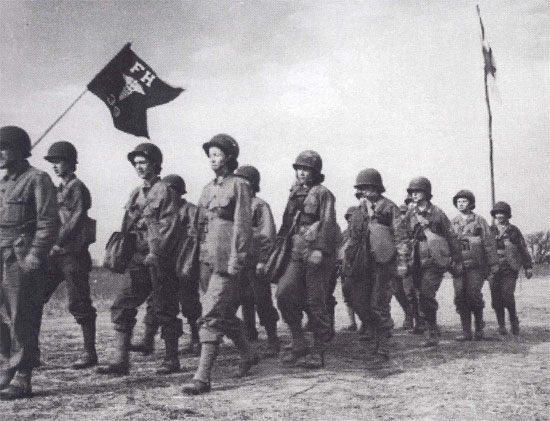
Conditioning hike ANC personnel. Nurses take part in a 6-mile hike while in bivouac at Cp. Ellis (ASFUTC), Illinois. Picture taken in October 1943. From L to R: NCO Dan Cadoravac (leading with 39th Fld Hosp Guidon), followed by ANC personnel, 2d Lt. Helen L. Erspamer, 2d Lt. Eunice M. Beardslee, 2d Lt. Beatrice Duffy, 2d Lt. Mary C. Callahan, 2d Lt. Sally Lou C. Strong, 2d Lt. Ann M. Morrissey, 2d Lt. Vida E. Casper, and 2d Lt. Avis M. Bonnet.
The Hospital consisted of 3 Platoons (officially designated Clearing Stations), and a Headquarters Company, which could operate as a self-sufficient unit comprising a command and operations staff, including the necessary doctors, nurses, technicians, and support and maintenance personnel. The Platoon Commander reported directly to the Hospital CO, who in turn reported to the Ninth Army Air Force.
Private O’Keefe was one of the maintenance Technicians assigned to First Platoon (1st AFCS) as a unit electrician. His main job consisted in keeping the electrical power source the Hospital was using at the time, ready and operational so that the unit could do its job to provide surgical and emergency care to the Army Air Forces personnel stationed within its geographical area.
(The 39th Field Hospital had meanwhile been activated at Cp. Ellis, Table Grove, Illinois (Army Service Forces Training Center, acreage 17,503, troop capacity 1,795 Officers and 24,654 EM) on 15 May 1943. From 24 November to 4 December, the unit trained at the Laurinburg-Maxton Airbase, North Carolina. On 5 December, the Hospital unit moved to Ft. Jackson, South Carolina for a last training phase before preparing for movement overseas).
The beginning of 1944 found the 39th Field Hospital temporarily stationed at Ft. Jackson, S.C. At that time, the unit was under the provisional command of 1st Lieutenant John D. Lynch, later replaced by a Major Wallace. On 5 January 1944, Major Henry “Salty” A. Seaman, MC, (the adjective “Salty” or “Old Salty’ was given during the Atlantic crossing, during which the CO was down with seasickness and had to be fed intravenously in sickbay) was assigned from the 120th General Hospital (Cp. Van Dorn, Centreville, Mississippi) to assume command (he only arrived on 11 January because of a delay en route). With the new CO came a number of inspections by the Fourth Service Command. Given the primary task of setting up a complete Field Hospital in THREE days, the men went to work! From 19 January thru 20 January, the unit worked hard in the rain and mud, night and day, preparing for inspection. Finally, at 0900 on 21 January 1944, inspectors from the Fourth Service Command found the 39th Field Hospital very capable of handling themselves in the field.
From 1 January – 23 April 1944, the Hospital would be assigned to the United States IX Air Force Service Command for quarters, rations, and administration. Its total strength at the time was 29 Officers, 20 Nurses, and 209 EM.

Partial view of Cp. Ellis, Table Grove, Illinois. Pfc Arnold Frost stands in front of one the 1/4-ton trucks (he became a Surgical Technician, and was one of the First Platoon Ward Masters). Picture taken around August – September 1943.
17 February 1944 found the 39th on full alert – this could only mean one thing – the last inspection had proved successful and the Hospital was now ready to fulfil the task for which it was trained!
Overseas Movement:
On Thursday 20 February 1944 the unit left Ft. Jackson. Twenty-four hours later it arrived at Cp. Kilmer, New Jersey (Staging Area for the New York Port of Embarkation). After a week spent in hard work and preparation for overseas duty, the Hospital departed from Cp. Kilmer at 2200, 26 February and reached Brooklyn Navy Yard at midnight the same day. Official departure took place at 0700, 27 February 1944, from Pier 10, with the full Hospital complement safely packed aboard the “Elizabeth C. Stanton” (AP-69). The ship was first to sail for England, and would then spend the ensuing 8 months operating between Oran (Algeria) and Naples (Italy).
Right before boarding, the men were overrun by American Red Cross girls handing out cups of coffee, donuts, fruit and candy. They also provided every man with a utility kit containing soap, razor blades, shoestrings, playing cards, mints, a writing pad, envelopes, a reading book, a sewing kit and few more useful items. As soon as the men were on the ship, everyone was assigned a bunk and received a life belt. During the long voyage, men were fed 3 ‘edible’ (apparently not very good, according to letters written home) meals a day. Luckily there was a PX aboard, and while cigarettes were aplenty, candy was rationed to 2 bars a man. The crossing was uneventful, and time passed more quickly than expected. The days were filled with sleeping, playing cards, eating, telling stories, getting to know sailors, and others on board.
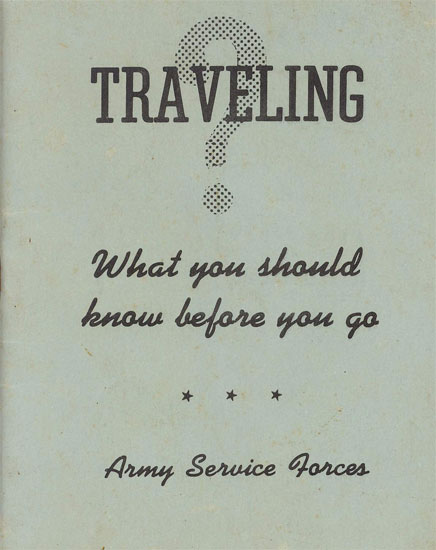
“TRAVELING” – What you should know before you go. Booklet prepared by the Transportation Corps and distributed by the Army Service Forces to US Army personnel traveling overseas. This handy pocket book provides a brief outline of the TC and its different services, and is designed to assist military personnel reporting for duty in Washington, or for departure to new Stations, either in the ZI or overseas. Ref. 24-35215 revised June 1, 1943.
On 7 March, the convoy rounded the northern tip of Ireland, the first sight of friendly shores in 9 days. This made a lot of homesick and seasick boys feel much better. From that very same day the 39th’s official assignment was with the United States Strategic Air Forces in Europe.
On 9 March, anchor was dropped in Bristol Channel, but due to heavy fog the ship couldn’t dock immediately.
England:
At 1800, 11 March 1944, everyone finally walked down the gang plank. After reassembly, the group departed from Newport, South Wales at 1930 arriving at their first destination, AAF Station 519 in the vicinity of Grove (Dorset), southwest of Oxford – west of London, the time was 2400 hours. The Hospital was still part of the IX Air Force Service Command. Men needed to become acquainted with their new ‘home’. It was cold with strong winds blowing, and there was black-out and curfew, and rationing in the country. Nissen huts became homes to all servicemen and women, though after a few weeks the Nurses were allowed to move to a room in the base Hospital. First Platoon had a complement of 6 Nurses, consisting of two First Lieutenants and four Second Lieutenants. Social life developed gradually, with dances once a week, post theaters, and “Liberty” runs to Oxford. On 12 March, the units were now temporarily attached to the 31st Air Transport Group for rations, quarters, and administration.
Some time around mid-March Harold O’Keefe was busy doing some electrical work and thought this was a perfect opportunity to get the job of maintenance utility which went with a Tec 5 rating (i.e. Technician 5th Grade, equivalent to Corporal), but he missed the boat, and another guy with less experience got the job. In the end, after having spent almost 20 months in the Army, Harold O’Keefe became the Hospital’s electrician and utility man, he now felt he not only had a better job, but could contribute much more to the war effort.
On Wednesday 5 April, an advance party of the 1st AFCS left Grove, Dorset, England. The group consisted of Major Paul C. McAndrew, MC, O-589244, Captain William W. Jack, MC, O-419186, 1st Lieutenant Courtney C. Bowen, MAC, and 12 Enlisted Men (the remaining personnel including the Nurses weren’t to leave before 10 April).
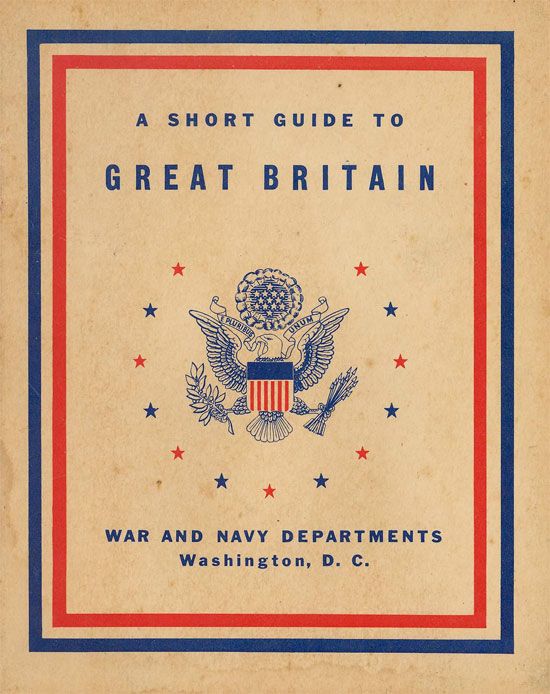
“A Short Guide to GREAT BRITAIN”, prepared by the Special Service Division, Army Service Forces, U.S. Army and distributed by the War & Navy Departments, Washington D.C. Ref. US Government Printing Office: 1944-O-583845. Booklet distributed to Servicemen serving overseas in the United Kingdom.
The 1st Air Force Clearing Station, 39th Field Hospital left AAF Sta 519 at 0800, 11 April (departing from “Andrews Field”) by air for a permanent change of station, with destination Fairwood, Wiltshire, where it arrived around 1000. The first leg of the journey took place by C-47 cargo planes, while the last nine miles were completed by truck. The rest of the month was dedicated to preparation of equipment and supplies, while still living under tentage. There was absolute need for many improvisations, and cupboards, bed stands, desks, as well as numerous small appliances had to be built from scratch. The Nurses were kept busy sewing wrappers for sterile supplies, wristbands for surgical gowns, and washcloths. The 6 Nurses had to do with a single Pyramidal tent (under normal conditions, they were allowed two). Baths were available, but only once a week at a nearby Station Hospital. Sibley stoves heated the tents, but personnel were responsible for hauling fuel and wood. Personal laundry was handled in helmets with water heated either on stoves or by immersion units.
The plan called for subdivision of the Platoon into an “advance 40-bed Surgical Hospital” unit and a “60-bed Evacuation and/or Convalescent Hospital”. Equipment of all kinds, including administration and office equipment, medical supplies, kitchen appliances, were all subdivided on the 40/60 basis. This called for a complete inventory of supplies, a record of shortages, and a list of equipment to be restored. From a mass of boxes, crates, and tents, emerged a unit, ready to operate and carry out its mission. A complete furnished surgical unit, with the necessary supplies and infrastructure for treatment of casualties was the first priority at hand, and very shortly thereafter, the evacuation unit was completed. All equipment needed to be painted with identification numbers in order to facilitate sorting, loading, and uncrating for any subsequent move.
Meanwhile Training continued, tents were pitched and taken down and more equipment arrived (the entire Hospital was to be dismantled in a mere 6 hours). Electricity was now provided by a field generator, this in turn allowed for installation of lights and radio equipment. A Day Room was constructed out of spare lumber and salvaged materials. Newspapers, magazines, writing tables, were made available in adequate quantities. Athletic equipment began to filter through as well, such as bats, balls, and gloves. “Liberty” runs were organized to Braintree (for recreation), while the Red Cross organization provided help in the form of showers.
The remainder of April was spent in procuring supplies for the three Platoons. The CO, Major Henry A. Seaman kept informal inspections at all times, while putting into effect his own system of operations and coordination between the different platoons. Personnel were exhausted at day’s end, but everyone seemed to understand that the extensive training programs would one day pay off in the field!
On 19 April 1944, First Platoon suffered its first casualty. As a result of enemy air action, Tec 5 Ernest L. Murr, ASN 37610661, was evacuated to the 121st Station Hospital at Braintree, Essex, for treatment. He received the “Purple Heart”. This was caused by increased German night raids over Britain.
On 23 April, the Hospital became attached to the 43d Air Depot Group for rations and quarters.
Hospital personnel were learning more and more about life in Britain. While the country looked beautiful, homes were practically all built out of stone and brick, there was hardly a house built of wood. Streets and roads were generally narrow, and strangely traffic moved on the left rather than on the right. Of course England had been at war for almost five years and therefore certain allowances had to be tolerated. The British took an active part in the war from kids to the elderly and the population had to do without many things. Food was rationed and clothing coupons restricted. The beer in England was usually very dark and tasted nothing like the one in the States. There were more women than men around and from what can be seen and heard, some of them were pretty, some of them were not …
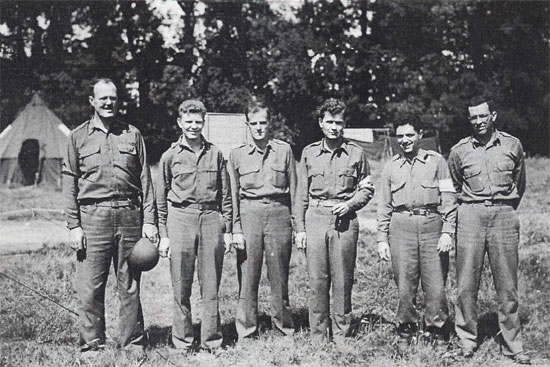
First Platoon Officers (1st AFCS). From L to R: Maj. Paul C. McAndrew (MC), Capt. Leslie C. Holshouser (DC), Capt. William W. Jack (MC), Capt. Alexander R. MacKay (MC), Capt. Daniel Luger (MC), and 1st Lt. Courtney C. Bowen (MAC).
Servicemen and women were paid in English currency, with shillings and pence to get used to, and one Pound Sterling equalled about 4 US Dollars in our money.
Total strength First Platoon – 31 May 1944
6 Officers – 6 Nurses – 57 Enlisted Men
Private O’Keefe was in Hospital for 2 weeks test, not only exhausted because of the hard work, but also down with mononucleosis. While reminiscing about home, he really got homesick, and kept inquiring about his wife (who was expecting another child) and son. He was worrying about who would mow the grass cut the hedges, and tend to some of the daily tasks in the forthcoming spring and summer seasons. There was also a certain eagerness to keep record of what happened in his hometown, so he requested that the candy and other goodies sent from home be wrapped in a newspaper, so that he could read about the old town himself.
Apart from the daily schedule and continuous training, followed by more inspections in May, there were a few accidents involving one Officer and an Enlisted Man. Passes were now obtained, and Harold was able to visit the city of London, which he extensively described in one of his letters to his wife. He did mention, be it in few words only (due to censorship), the results of the Blitz and the many ruins in London, which made him realize how fortunate the people in the Zone of Interior were, to live in a country that really never felt the blunt of the war, except of course for the heartaches caused by being separated from one’s loved ones serving on foreign soil.
The month of May, found Lt. Colonel Henry A. Seaman, MC, (he was promoted 18 May 1944) an extraordinary busy man. He had effected several inspections at each of his 3 Platoons and also spent quite some time at Ninth Air Force Headquarters. There were not only rumors spreading, but it seemed as though things were about to happen soon, and everyone was naturally anxious to know just what! June 1944 would turn out to be one of the most historic events of the year and the 39th Field Hospital was about to face its destiny and play its part.
France:
As the trip across the Channel loomed closer, the Nurses became more and more anxious to put the unit’s preparations to the test (there were no patients during this preparatory period). During the alert stage (it should be noted that the 39th Fld Hosp had been first alerted on 25 April 1944), several conflicting orders governing the packing and labelling of supplies and luggage were received and carried out. First Platoon was fortunate that they had kept their original luggage intact up to this point, although they were now ordered to streamline and take only field uniforms and gear along. Leaving Seersuckers, Class A uniforms and accessories behind in footlockers and bags, the platoon packed their remaining luggage for movement. These preparations proved invaluable since it would take several weeks after their arrival on the continent for the remainder of their baggage to catch up with the unit. From 1 – 5 June, it was business as usual, but then tempo suddenly increased, the CO was making more inspections and Captain/Chaplain Harold V. Meima, ChC, was conducting extra services …
On 2 June 1944, Private O’Keefe received a first promotion, he was a now a Private First Class (Pfc), which enabled him to put a few more bucks aside to send home to his pregnant wife and kid.
Everyone was now eager to see the long-awaited Invasion take place, also the folks at home were expecting something ‘big’, for it might bring the boys back home much faster. Then on 6 June 1944 came the news that the Allies had landed in France! D-Day had finally arrived, and the Krauts must be on the run! Although everyone was excited with the news, the 39th felt disappointed that it had not been chosen to be one of the medical units to go in with the main assault force.
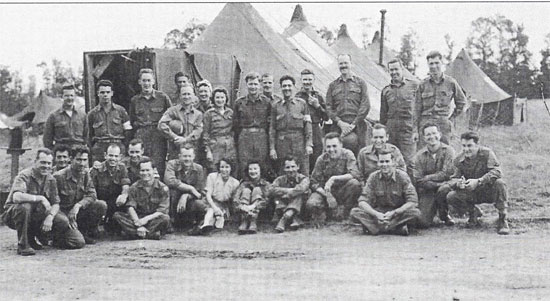
Hospital Staff, 1st AFCS, 39th Fld Hosp, in front of the “Admission” Tent. Another picture taken during their stay in Normandy (June – September 1944).
It wasn’t long before the unit was to leave Braintree, Essex. And after another alert, marching orders were received and the unit left base 12 June after having loaded its equipment onto a number of 2 ½-ton cargo trucks. The convoy left at 1100 while the remainder of the platoon departed by train. Its new destination was Camp C-13 in Southampton, where it arrived around 1930 the same day. The 39th Field Hospital proceeded to the marshalling area with full combat gear. During the next six days, nothing happened, yet everyone was anxious to make the crossing, but day after day went by, with the men and women remaining at C-13. Meanwhile, final preparations went on, with much time dedicated to waterproofing gasmasks, exchanging British money for Invasion currency, and drawing the necessary rations. Everyone lived out of their musette bags and individual luggage, as all other equipment and supplies had been packed and stored for the move. On 13 June, all tents were taken down and packed, and Headquarters were ready to move at short notice, yet no orders arrived. Late on June 15, 1944, it was night, 2330 hours, the men noticed something special moving rapidly through the air, it was their first buzz-bomb (V-1 pilotless or robot plane) coming over their area. There would be more to follow…
Finally, on Friday 16 June, an advance party of the 1st AFCS, with Captain Leslie C. Holshouser, DC, in charge, departed. All vehicles had been duly waterproofed and sufficient equipment was available to enable the unit to start operating until the remainder of the supplies arrived. The following day, the rest of the First Platoon left C-13 for Southampton. Another delay, lasting three hours, prevented the embarkation process. At 2200, everyone finally boarded LCI No. 421 (Landing Craft Infantry) which took off about a half hour later, during an enemy air raid. The landing craft anchored outside the harbor, with hundreds of ships of various sizes surrounding her. Sometime during the night of 18 June, LCI No. 421 left Southampton for its trip across the Channel. The morning of 19 June was overcast and misty and the trip had been a bit rough causing some seasickness among the medical personnel. After arriving off Omaha Beach, the sea had roughened up and it was impossible to land. The ship even lost both stern and bow anchors because of the heavy seas and for the next 3 days the craft was severely tossed about. The crew tied up with larger ships several times, only to have the hawsers snap during the night. It was rough and dangerous, and it was to the credit of the naval Officers and crew that the vessel didn’t collide with any other ship or wreckage in the water. The LCI was even adrift for a while, its engines having stalled and the hawsers having broken loose from the nearby Liberty ship to which it was tied for protection. In the end everybody made it, and First Platoon landed safely on Omaha Beach, Thursday, 22 June 1944, at 1930 hours.
The platoon was taken to a pier in small vessels before being able to set foot on French soil. Then they waited for several hours until transportation arrived in the form 6 x 6 trucks which took the entire unit’s hand luggage. There was another wait for additional transportation, after which some of the men were taken to a Château (recently vacated by the Germans) where they spent the remainder of the night, sleeping without blankets on a stone floor. The rest of the platoon had to hike up the hill to reach the Château (this could have been the Château de Beaumont ?). The next morning (23 June), everyone was off to the new position, a ‘cow pasture’, which was actually a field near ALG A-3 (in the vicinity of Cardonville), where digging foxholes became first priority. The unit was however able to set up and started functioning within 12 hours after arrival! The advance party led by Captain Holshouser arrived several hours later and the supplies he brought were set up promptly. The entire Hospital unit was established and ready to operate. Apart from some field improvisation, personnel went scrounging abandoned enemy fortifications discovering many articles found lacking.
(ALGs or Advanced Landing Grounds were temporary airfields constructed within days following the D-Day landings in order to enable the relocation of tactical air support from southern England to Normandy. They could then be used for close air support, bombing, supply, and evacuation missions. As soon as enemy forces had been driven out, personnel pertaining to the IX Engineer Command came in to start construction. ALG A-3 near Cardonville, Normandy, measured 5,000 feet in order to accommodate fighter-bombers, it was completed 19 June, and extended 24 July. The 368th Fighter Group, flying P-47Ds and operating out of A-3 was the first group to be stationed on the continent. ALGs operated by the USAAF were designated by prefix A followed by a number, while those operated by the RAF were denoted by prefix letter B. The building of such additional airfields allowed the IX Tactical Air Command to start operating on the continent as from 16 June, with first missions taking off and landing at ALG A-2, located near Cricqueville in Normandy).

Partial view of 1st AFCS installation, at Cardonville, France (near ALG A-3). Picture taken course of July 1944.
Due to the proximity of the front not much mail got through during that particular time, and personnel in the field had to do without news from home, whereas their relatives and next-of-kin were anxious to learn what happened to their loved ones who were now engaging the enemy in a foreign land. Living under field conditions proved interesting. All personnel slept in foxholes. When the situation allowed this, orders were issued for personnel to be housed in pyramidal tents and Officers in small wall tents with foxholes nearby. Rations at first were all of a sole variety, “K”. When the generator arrived, a recreation tent was set up containing a radio and short motion pictures were secured. Then mail arrived, and this turned into one of the greatest morale boosters.
The 1st AFCS was now set up and ready to receive patients from Monday 26 June, 0800 hours, onward, as per orders. The very first surgical case handled was an emergency appendectomy performed by Captain Alexander R. MacKay, MC, at midnight. The unit had several more busy nights with surgical cases resulting from bombings, plane crashes, or vehicle accidents. Initially they far outnumbered the routine medical cases. It wasn’t always easy to operate amid the incessant din of ack-ack fire. War was still very close to the area, and frontlines were only a few miles away. In addition to caring for Air Force personnel, First Platoon often treated casualties from nearby ground units, and general dispensary services were rendered to many units operating without proper medical care. First Platoon was to remain in the area for the next three months.
The 39th had at last reached the goal for which it had long strived. The beginning of July 1944 found it very close to the front. Each individual platoon had an airstrip to administer medical care.
1st AFCS > ALG A-3, Cardonville, Normandy
2d AFCS > ALG A-1, St. Pierre-du-Mont, Normandy
3d AFCS > ALG A-2, Cricqueville, Normandy
Duty hours ran from 7 to 7, and the only recreation consisted of passes for visits to Cherbourg and Mont-St.-Michel. Bed check was at 2300 and Nurses rotated each two weeks on night duty, each four weeks in the OR and each four weeks on the wards. They also alternated in doing the Officers’ and Nurses’ laundry, including the Hospital laundry. Drying was difficult because of the damp climate, and had to be done by means of a separate tent heated with stoves. Problems arising the initial week of operations were many but had been solved by ingenuity . The source of running water for the OR was prepared from two empty gas cans, copper and rubber tubing, and wood. The sink was constructed from a salvaged ammo box. Numerous other devices, such as crutches, heat cradles, stands, and small cupboards were improvised from spare lumber.
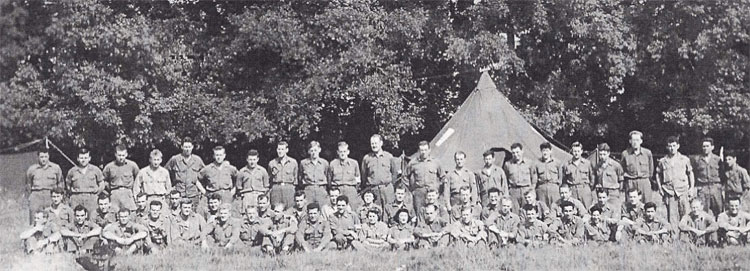
1st AFCS, 39th Fld Hosp, personnel in front of one of the M-1934 Pyramidal Tents. Pfc Harold F. O’Keefe is the second last person standing on the right (back row). Picture taken in June/July 1944.
Total strength First Platoon – 31 July 1944
6 Officers – 6 Nurses – 58 Enlisted Men
| General Daily Schedule (July 1944) | |
| 0645 hours | Reveille Breakfast for Enlisted Personnel |
| 0700 hours | Day Nurses to Duty and end of Night Duty Breakfast for Officers |
| 0715 hours | Report for Day Duty Sick Call Breakfast for Nurses and Patients |
| 0900 hours | Officers’ Call Requisition into Supply and Pharmacy Mail Collection |
| 1100 hours | Pick-Up Requisition – Exchange of Linen |
| 1145 hours | Lunch for Ward Personnel |
| 1200 hours | Lunch for Hospital Personnel |
| 1300 hours | Report for Duty Requisition into Supply |
| 1500 hours | Pick-Up Requisition |
| 1645 hours | Supper for Ward Personnel |
| 1700 hours | Supper for Hospital Personnel Supper for Hospital Patients |
| 1730 hours | Report for Duty |
| 1900 hours | End of Day Duty and Night Duty begins |
| 2245 hours | Taps and Lights Out |
| 2300 hours | Bed Check |
Electricity was another concern. A good deal of surgery was performed during night hours, which required running the generator day and night. By restricting its use during night, a fairly good adjustment was made possible. A salvaged German generator was used part time but proved to be unsatisfactory. It was a DC unit and special equipment, such as suction motor, and washing machines, would not function on DC current. Many American appliances ran on AC current and this caused many a problem. Pfc Harold F. O’Keefe, ASN 32596985, and Pfc John J. “Mickey” Finn, ASN 32927795, were responsible for the electricity. Furthermore the German-made generator consumed too much gasoline and broke down too many times, in the end there was no solution but to try and keep it working whatever the problems, in order to support surgery operations, thus it could not be simply abandoned. As already noted a storage tent had been set up for helping dry the heaps of continuous laundry, unfortunately a fire broke out on 28 July ruining the complete tent, the laundry, and some stored equipment. Luckily the weather started improving, and laundry could now be dried outside during daytime. Social life remained limited, one of the highlights being the weekly or bi-weekly visit of a portable shower unit, together with organized inter-platoon visits and friendly baseball and softball games. Movies were rather few, and unfortunately often arrived during duty hours, limiting the number of people that could attend them. Improved mail delivery helped keep morale high, as a matter of fact, Pfc O’Keefe all of a sudden received an accumulated 25 letters, all dating back to the month of June.
The first patients had been received since 4 July and continued to pour in. After an inspection visit by a group of Ninth Air Force staff, some of the pending problems were gradually solved and ironed out. On 13 July, First Platoon’s equipment that was left in England arrived at intervals during the evening, supplementing the extra supplies delivered with help of the Army Air Forces two days before. Lt. Colonel Seaman became a pleased and proud man when his captured German staff car was returned to him on 18 July, refurbished, freshly painted, and ready to go to work as his personal vehicle.
On 29 July, Lt. Colonel Henry A. Seaman (CO > 39th Fld Hosp), a brain specialist, and Captain Francis O. Ward, MC, O-367348 (3d AFCS) were called to First Platoon early in the morning to operate. The Germans had dropped delayed action bombs on a truck convoy full of ammo. Most of the men were killed but those surviving were taken to the platoon for treatment. Lt. Colonel Seaman successfully performed one of the most difficult brain operations he had ever encountered. The CO operated at all platoons and completed many operations successfully. He also continuously supervised and issued directions on performing operations and handling of patients that proved very helpful.
The month of July brought some big news to Pfc O’Keefe; on 31 July 1944, his wife gave birth to another son, christened Harold John (he however was only to find out by 12 August)!
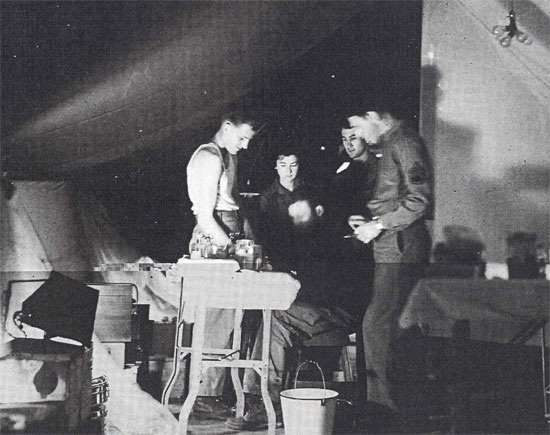
Personnel of First Platoon inside one of the medical tents. Picture at Cardonville, France, July 1944.
August 1944 was the most intensive period for the Clearing Station, and until the last days of the month, First Platoon was very busy and had a constant census of about 60 patients, despite a rapid turnover. The increased activity was caused by the increase in the number of temporary and fixed airfields. Units of the Ninth Air Force from as far as 80 miles from the platoon’s base, brought patients, and with the movement of the 2d AFCS to another location, all units they were serving now came to this installation. Because Allied forces were advancing so rapidly, with Air Force units moving up too, difficulties for supplying equipment, food, and water, arose. The latter was an important item, since the Hospital was using close to 2,000 gallons of water a day.
In general battle casualties decreased in numbers, but injuries from mines, booby traps, and live ammunition were still frequent though in lower numbers. Injuries from sports and athletics increased however. Social life and recreation improved considerably, movies were presented with greater regularity, USO shows were booked, and visits organized to large cities and to Mont-St.-Michel without interfering with the hospital routine.
Total strength First Platoon – 31 August 1944
6 Officers – 6 Nurses – 59 Enlisted Men
During the first weeks of September the professional duties of the organization were extremely light because of the advance of all Ninth Air Force units from the area. There was now a little more time for rest and relaxation following the steady work of the previous weeks.
On 8 September, an advance party consisting of 12 Enlisted Men under command of 1st Lieutenant Courtney C. Bowen, MAC, left for Alençon where a site had been selected for the Hospital. The 39th had set up in the new location though it did not yet open for patients. On 10 September the party returned quickly to its original site at Cardonville, and on the same day the entire Platoon left for Grugies, France, their new station, having entrucked on a “Red Ball” convoy (with vehicles provided by the 1576th Quartermaster Truck Company, (Aviation). It stayed overnight at the Third Platoon’s new Hospital site in Chartres, enjoying the hospitality of a hard building with spacious quarters, and an opportunity to meet with some of their buddies of the other platoon. On Monday 11 September, the unit continued its journey to Grugies, and after arrival immediately set up the hospital. Organizations serviced in the area were those Army Air Force units stationed at ALGs A-71, A-72, A-73 and A-74. Morale of the troops was good, as evening passes and visits were organized to the town of St. Quentin. Personal acquaintances were made among the local inhabitants of the neighboring villages, and men were often received as guests in private homes were they were served excellent food. The Platoon mess enjoyed fresh vegetables obtained from the gardens at A-71. Motion pictures came through and one entertaining show was presented as well by men from the 32d Special Services Company.
Bed capacity was already filled within three days. Although being an Air Forces Clearing Station with a basic 100-bed capacity, the unit had 150 patients at one time, and the average census reached 120 the last two weeks of the month. It should be noted that the platoon also took care of ground troops in the area, enemy PWs, and French civilian patients.
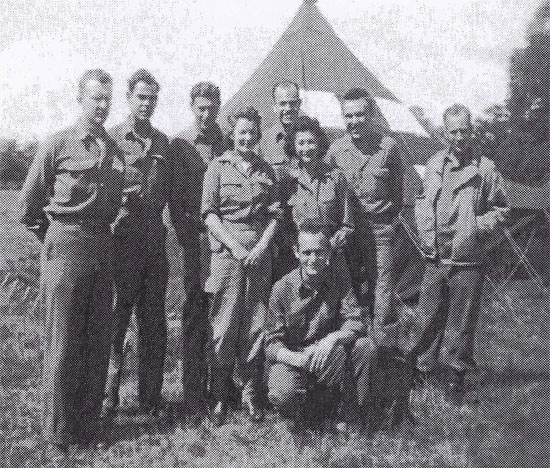
Picture taken at Cardonville, Normandy, July 1944. From L to R: Arnold Edwards, Raymond E. Thompson, Paul-Gerhardt Lion, Eugene J. Grotjohn, Andrew J. Foray, Milburn J. Whiteford (back row), Marjorie E. Strong, June H. Friedman (Nurses, middle row), John Flanagan (kneeling).
On 15 September 1944, Tec 5, Harold F. O’Keefe, 1st AFCS, 39th Field Hospital, was electrocuted and died instantly (at 1145) near Grugies, France, while performing his duties as a unit maintenance technician. At the time, he was endeavoring to secure an adequate supply of electricity for the Hospital to supplement the overburdened generators used. Harold O’Keefe was noted for his original ideas and his boundless energy, and his efforts had been redoubled when he got promoted from Pfc (Private First Class) to T/5 (Technician 5th Grade). His sudden death was deeply felt by all the Officers and Enlisted Men of the organization. Harold O’Keefe was the sole casualty for September 1944.
(There was nothing but trouble with the generators and they broke down frequently. Electricity was a necessity in order to properly perform the many operations and related tasks. Harold O’Keefe and John Finn tried everything to keep the generators running. It was Major Paul McAndrew (CO > 1st AFCS) who came up with the idea of taping into and using the local French power to replace the unstable generators. The services of the Corps of Engineers were secured and they dispatched a young Lieutenant to Grugies. The town had power lines going through the Hospital’s site and these lines were accessible to First Platoon. As the Lieutenant was about to climb up the pole to test the lines, he handed Harold a test box. As soon as the Officer was clamping onto the high voltage lines, he got severe burns on both hands – to the point of losing several fingers – while Harold – who was holding the test box – was killed instantly by the high voltage surge. Several of the medical staff attempted artificial respiration but to no avail! Harold was killed instantaneously by what was estimated 15,000 volts of electricity. Tec 5 Harold F. O’Keefe remains were then taken by ambulance to a Graves Registration unit, escorted by 1st Lieutenant Courtney C. Bowen and Tec 5 William W. Brindle).
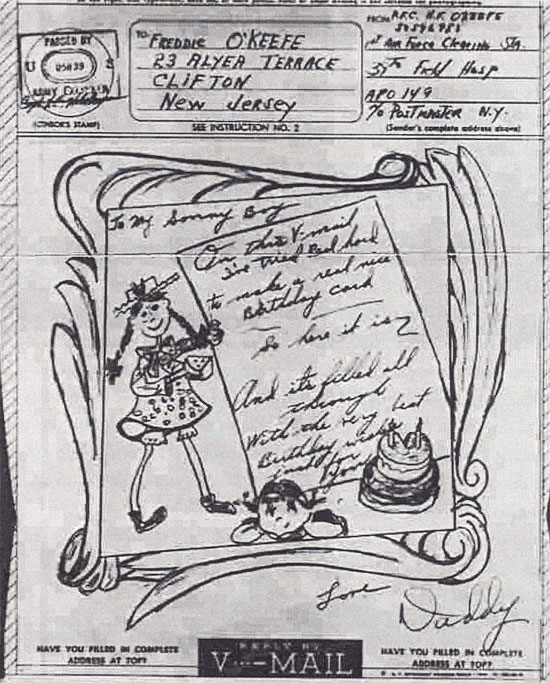
Copy of V-Mail “Birthday Card” sent by Harold O’Keefe to his son Freddie (dated 18 Aug 44) with selfmade drawing for his son’s second birthday.
On 28 September, First Platoon was again alerted for a permanent change of station. The new location was to be Belgium. Movement began on 29 September with the assistance of a number of 2 ½-ton trucks and half-tracks secured from the RTO at Laon by Major M. H. Meader and the Town Major of St. Quentin. The unit arrived at Hoegaarden, Belgium, on 30 September 1944.
Total strength First Platoon – 30 September 1944
6 Officers – 6 Nurses – 58 Enlisted Men
1 October 1944 found the 1st AFCS operating at Hoegaarden, Belgium. This was the first time that the unit had been set up in a building, and the change was welcomed by everyone. It was a wing of a Catholic Girls’ School, four-stories high, a solid brick structure, and large enough to accommodate the entire hospital unit. The building belonged to the “Sisters of the Union of the Holy Heart”, who had been extremely cooperative with maintenance, help, even providing soup and fresh fruit. The local chapter of the Belgian Red Cross and the population of Hoegaarden and Tirlemont were equally cooperative, often sending large baskets of fruit and flowers to personnel and patients.
Total strength First Platoon – 31 October 1944
6 Officers – 6 Nurses – 60 Enlisted Men
November had passed quickly and quietly with very little happening. Average patient census was between 61 and 73. Armistice Day, 11 November 1944 was celebrated and a small detachment of 16 EM commanded by 1st Lt. C. Bowen marched in the parade together with the Belgians. The men were later entertained with free beer offered by the Hoegaarden Brewery. The highlight of November however was Thanksgiving Day, and the traditional turkey dinner served in the mess was the best meal the Hospital had probably ever served! There was enormous improvement in entertainment, thanks to receipt of a motion picture projector, which allowed for two or three shows each week. In addition, two USO shows were obtained, which were not only highly appreciated by patients and personnel, but also by a group of Belgian policemen quartered in one section of the Hospital buildings. On 13 November, the unit was inspected by a high delegation of the Ninth Air Force.
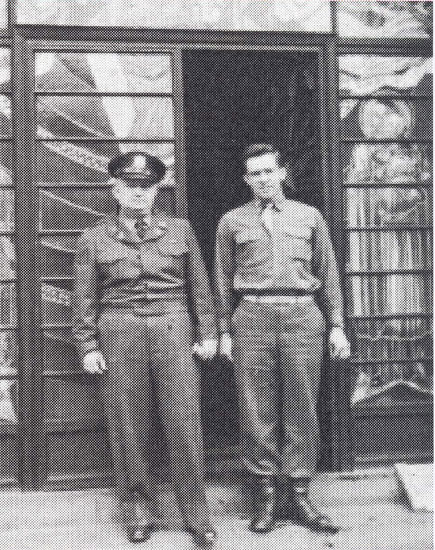
Picture of Lt. Col. Henry A. Seaman (MC) CO 39th Fld Hosp, and 1st Lt. Courtney C. Bowen (MAC) Adjutant, Historical Officer 1st AFCS.
Total strength First Platoon – 30 November 1944
6 Officers – 6 Nurses – 62 Enlisted Men
Mid December 1944, the “Battle of the Bulge” suddenly broke out, during a severe winter, one of the coldest in decades. While Americans were trying to beat back the enemy, the Russians were making spectacular advances in the east, towards the German capital city Berlin. The enemy breakthrough threatened some of the 39th Platoons (at the time the 3d AFCS was stationed at Charleroi, Belgium, while the 2d AFCS was established at St. Quentin, France, really out of harm’s way). First Platoon was subsequently ordered to evacuate all its Nurses and patients to Third Platoon in anticipation of a six-hour move from their area (in fact they never moved). The 3d AFCS was under enormous strain during this unsecure period, but with help of the 130th General Hospital within the vicinity, the extra Nurses from First Platoon, and additional ambulances on loan from the IX TAC Surgeon, they were able to cope with the situation. For the first time, the number of ground forces patients exceeded those of the Army Air Forces. Although the ORs were in constant use, there was still some time to celebrate Christmas and New Year.
Total strength First Platoon – 31 December 1944
not available
1 January 1945 was a day long to be remembered, for the day started at 0430 when a British soldier was admitted with wounds in the thigh and abdomen. This was the first of a series of 14 cases resulting from German strafing of nearby Allied installations. Surgery continued until 0400 the next morning. After 2 January, the remainder of the month became routine. Census averaged between 57 and 69 patients, and was never over 70. As the battle continued the influx of casualties really never stopped. During January, passes resumed and one-day trips were organized to Brussels. From 14 to 24 January, Major Carlton A. Fleming, MC, O-506347, was on SD from Headquarters as acting CO, in the absence of Major Paul C. McAndrew, MC, O-309244, who was being treated for ill health at the 1st General Hospital during that period. 1st Lieutenant Mary F. Render was appointed Chief Nurse.
Total strength First Platoon – 31 January 1945
6 Officers – 6 Nurses – 64 Enlisted Men
February was a month of few changes and very few problems were noted. Rotation of medical personnel within the unit was still carried out because this kept everyone familiar with each specific department of the hospital. Some Officers who had been on TD with the other platoons now returned. With the Allies on the offensive and moving further east towards Germany, 80 to 90% of the patients were now Air Force personnel.
Some transfers took place during the month. Three Nurses were transferred to Second Platoon, one Officer and one Nurse returned from assignment, and a new Nurse was welcomed. A few extra hands were received from the 12th Reinforcement Depot, from Ninth Air Force Headquarters, and from the 1st General Hospital. Some men switched places with 2d AFCS personnel.
Total strength First Platoon – 28 February 1945
7 Officers – 6 Nurses – 62 Enlisted Men

Copy of a letter (postmarked 16 Feb 45) sent to Mrs. Harold F. O’Keefe by Major Paul C. McAndrews, MC (CO > 1st AFCS).
On 9 March 1945, an advance party departed from Hoegaarden, Belgium for another permanent change of station, with the remainder of First Platoon and the bulk of its equipment following the next day. All safely arrived at the village of Bies, Holland, the same day. The new site was part of a Boys’ Parochial School building. Several days had to be spent in cleaning the building due to its rather poor state. The stay in Holland would be uneventful and rather short, with a patient census being nowhere near to what it had been over the past months. During that particular period there were four cases of scarlet fever, one case of measles, and a near fatal case of WP burns. While packing, frantic parents brought in a five-year old Dutch boy who had wandered away and stepped on a German mine. Medical Officers and Nurses tried to save him, and everyone was heartbroken when the little boy died.
On March 30, the unit moved again, back from Holland to Belgium, but now to the town of Maaseik. Since it was a brief move, there were no incidents to report.
Total strength First Platoon – 31 March 1945
6 Officers – 6 Nurses – 67 Enlisted Men
31 March 1945, Maaseik, Belgium, the unit was set up in a modern building, spotless clean, bright and airy, without doubt the finest place ever occupied by First Platoon. Its location was much closer to the nearby airfields to be serviced. During the first half of April, Airfields Y-29, Y-30, Y-44, and Y-55 were mainly occupied by Fighter Groups, but with the rapid progress of the Allied Forces into Germany, groups pertaining to the 9th Bombardment Division gradually took over. Daily average varied between 30 and 50 patients. There was time to make some re-arrangements in the layout of the building, since part of the personnel was quartered in another house across the street and away from the main building. More space was therefore secured in another school building just around the corner. As the city of Maaseik had no water system, the Hospital used its own pump and storage tank for bathing and washing, while water supplies used for cooking and drinking came from other sources. A VD Control movie and other Training films were shown to all personnel, and on 26 April, a ‘live’ jeep show, courtesy of the 16th Special Service Company, entertained the patients.

Picture of Elwood B. Smith (aka “Rocky”) and Florence D. Jedrezak (aka “Jed”) at their wedding in Belgium.
Total strength First Platoon – 30 April 1945 > 30 June 1945
not available
The Hospital had been moderately active during April. On 8 May 1945, everyone in town celebrated VE-Day, and a grand community dance was held in the town square. In May there were a reduced number of patients resulting from the unconditional surrender of Germany and the movement of Army Air Force units away from the nearby airstrips. New orders were received directing another change of station to the vicinity of Cambrai, France. After securing a TB Preventorium for its use, the advance party, upon arrival was informed that the building had been turned over to the French authorities and was no longer available. Another site had to be selected.
A new advance group was formed which left Maaseik on 17 June. The remainder of the Hospital unit and equipment arrived on 18 June 1945. First Platoon set up their installations in the small Château at Havrincourt, France, with additional tents for Dispensary, X-Ray Department, and Day Rooms. The plan was to house the patients in the Château and if circumstances warranted, ambulatory and ambulant convalescents would be put up in tents.
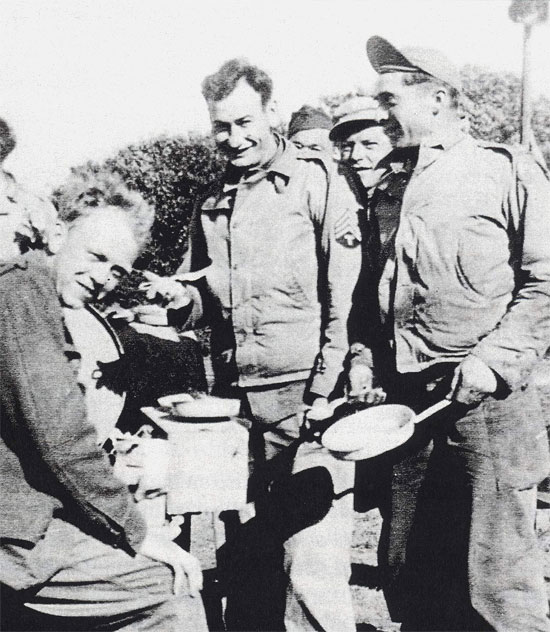
Picture taken around the first week of September 1945 (before tragedy struck) illustrating some 1st AFCS members. Red Hanson (L), Charlie Wilson (standing), Harold O’Keefe (R). It is probably one of the last pictures showing Tec 5 Harold F. O’Keefe.
The outstanding social event was the wedding on 21 June 1945, of 1st Lieutenant Florence D. Jedrezak, ANC, N-772389, and 1st Sergeant Elwood “Rocky” B. Smith, MC, ASN 36510260. After receiving the necessary approvals from the Ninth Air Force Command, and with assistance of the local Mayor, who helped expedite the required official documents, the couple were married in the Mayor’s office. A complete Church ceremony followed. The bride was given away by Major Carlton A. Fleming, (CO > 3d AFCS) with S/Sgt George C. Ogborn as best man. The wedding present was a seven-day honeymoon to Paris with the best wishes of the entire Platoon.
Daily routine continued, with few battle casualties. The evacuation of patients was entirely by ambulance to Army General Hospitals. When in Maaseik, this was to the 25th General Hospital at Tongres, Belgium. At present, in Havrincourt, patients were evacuated to the 197th General Hospital in St.Quentin, France.
Because of the limited amount of work, the Nurses had time to relax. As a result of this all leaves could be completed and monthly passes honored. There was even time to conduct a complete dental survey of the unit.
July and August were spent with the daily routine in effect, uneventful, except for the rumors about either being transferred to the Pacific to fight the Japanese, or simply going home for a possible Discharge!
Total strength First Platoon – 1 July 1945
6 Officers – 6 Nurses – 52 Enlisted Men
On 8 September 1945, formation took place at 1100 with presentation of Good Conduct Medals. The CO called the Hospital together and addressed all personnel in the mess tent, with the promise that everyone would soon move out back to the States next October …
High Point men would indeed leave their unit and be transferred to Third Platoon. On 12 September, all personnel transferred to the 3d AFCS arrived in Amiens, France. While First and Third Platoon merged in France, other Officers and EM were sent to Germany, to join Second Platoon, at Bad Kissingen, Germany. Finally a group of men departed Le Havre aboard the SS “Argentina” on 18 October with destination New York, where they arrived on 25 October 1945 – some would sail for the States aboard the SS “Madawaska” on 26 November 1945 – no matter when or how they returned home – for them the war was truly over …
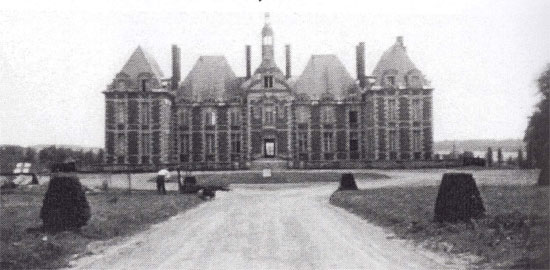
View of the Château, Havrincourt, France, where the 1st AFCS was set up from June – September 1945.
(The Western Union telegram announcing the loss of Tec 5 Harold F. O’Keefe emanating from the Adjutant General, Major General J. A. Ulio reached Frances K. O’Keefe on 2 October 1944. Meanwhile Harold F. O’Keefe had been buried on 16 September 1944 at the temporary American Cemetery #1 at Fosses-la-Ville, Belgium – Plot B, Row 5, Grave 100 – situated just outside the village. This Cemetery opened on 8 September 1944 and closed on 12 July 1948. 2,199 American soldiers were buried there with 96 Allied brothers in arms. Harold O’Keefe’s remains were disinterred and eventually returned to the United States for re-burial, with funeral services taking place at 1130 hours, 30 April 1949, in Long Island National Cemetery).
| Overview of Tec 5 Harold F. O’KEEFE’s unit movements (1st AFCS / 39th Fld Hosp): | ||
| Departure | 20 February 1944 | Cp. Ellis, Illinois |
| Arrival | 20 February 1944 | Ft. Jackson, South Carolina |
| Departure | 20 February 1944 | Ft. Jackson, South Carolina |
| Arrival | 21 February 1944 | Cp. Kilmer, New Jersey |
| Departure | 21 February 1944 | Cp. Kilmer, New Jersey |
| Arrival | 26 February 1944 | Brooklyn Navy Yard, New York |
| Departure | 27 February 1944 | Brooklyn Navy Yard, New York |
| Arrival | 09 March 1944 | Bristol Channel |
| Departure | 11 March 1944 | Bristol Channel |
| Arrival | 11 March 1944 | Newport, South Wales (disembarking) |
| Departure | 11 March 1944 | Newport, South Wales |
| Arrival | 11 March 1944 | AAF Station 519, Grove, England |
| Departure | 05 April 1944 | AAF Station 519, Grove, England |
| Arrival | 11 April 1944 | Fairwood, Essex, England |
| Departure | 12 June 1944 | Braintree, Essex, England |
| Arrival | 12 June 1944 | AAF Station 413, Cranbrook, England |
| Departure | 12 June 1944 | AAF Station 413, Cranbrook, England |
| Arrival | 12 June 1944 | Hursley, Marshalling Area, England |
| Departure | 17 June 1944 | Hursley, Marshalling Area, England |
| Arrival | 22 June 1944 | Channel Crossing by LCI No. 421 |
| Departure | 22 June 1944 | Landing at Omaha Beach |
| Arrival | 22 June 1944 | Slept in Château for the night |
| Departure | 23 June 1944 | Château de Beaumont (?) |
| Arrival | 23 June 1944 | ALG A-3, near Cardonville, France |
| Departure | 10 September 1944 | ALG A-3, near Cardonville, France |
| Arrival | 11 September 1944 | Grugies, France |
| Departure | 29 September 1944 | Grugies, France |
| Arrival | 01 October 1944 | Hoegaarden, Belgium |
| Departure | 10 March 1945 | Hoegaarden, Belgium |
| Arrival | 10 March 1945 | Bies, Holland |
| Departure | 30 March 1945 | Bies, Holland |
| Arrival | 30 March 1945 | Maaseik, Belgium |
| Departure | 17 June 1945 | Maaseik, Belgium |
| Arrival | 18 June 1945 | Havrincourt, France |
| Departure | 11 September 1945 | Havrincourt, France |
| Arrival | 11 September 1945 | Amiens, France |
| Personnel List of 1st Platoon (1st AFCS, 39th Fld Hosp) incomplete: | |
| Gilbert N. ACOSTA (Pvt, Pfc) | Paul ANDERSON (S/Sgt) |
| Robert V. ANDERSON (Tec 3, Tec 4) | William R. BAGENT (Tec 5) |
| Rudolph BAMBINO (Pfc, Tec 5) | John W. BAYSINGER (Pvt, Pfc) |
| Edwin BEIERLE (Pvt) | Fred U. BOCCHETTI (Pfc) |
| Arlie E. BOULTINGHOUSE | Joseph R. BORGES (Pvt, Pfc) |
| Courtney C. BOWEN (2d Lt 1st Lt) | Otto P. BRATSCH (Pvt) |
| William W. BRINDLE (Tec 5) | Melvin BROCUS (Pvt, S/Sgt) |
| Arthur L. CALDWELL (Tec 5) | Toivo A. CARLSON (Tec 4) |
| Arthur F. CARMICHAEL (Tec 5) | Chan H. CHASE (Cpl) |
| Donald A. CRAWFORD (Pvt) | Adison J. DAVIS (Tec 3, Sgt) |
| John B. DRUMM (Tec 5) | Arnold EDWARDS (Pvt, Pfc) |
| John J. FINN (Pfc) | John FLANAGAN (Tec 3) |
| Carlton A. FLEMING (Maj) | Andrew J. FORAY (Tec 5) |
| Nelmo FRATESCHI (Pvt) | Arnold FROST (Tec 5) |
| Carmello GAGLIA (Pvt) | Robert W. GALLOWAY (Pfc ,Tec5) |
| Reynaldo R. GONZALEZ (Pvt) | John J. GOODWIN (Pvt, Pfc) |
| Ben GRAGG (Tec 4) | Forrest GRANT (Pfc) |
| Darius L. GREEN (Pfc, Tec 5) | Belvis J. GREGORY (Pvt) |
| Eugene J. GROTJOHN | José G. GUTIERREZ (Pvt, Pfc) |
| A. C. HALL (Pvt, Pfc) | Thomas F. HANTON (Pvt, Pfc) |
| Fred C. HAUB (Pvt, Pfc) | Harold T. HEDGES (Tec 5) |
| Frank H. HORTON (Tec 5, Tec 4) | Orville E. HUTTON (Pfc, Tec 5) |
| William W. JACK (Capt) | Edward B. JOHN (Tec 5) |
| William JONDREAU (Tec 5) | Albert A. KANARAUSKAS (Pvt, Pfc) |
| Harold KAPLAN (Pfc) | Martin H. KIEFER (Pvt, Tec 4) |
| Gerald M. KING (Pfc) | Clifton A. LIGON (Sgt) |
| Paul-Gerhard LION (S/Sgt) | Mike O. LISARRAGA (Pvt, Pfc) |
| James D. LONG (Pvt) | John LUCAS (Pvt) |
| Daniel LUGER (1st Lt, Capt) | Fidencio V. LUNA (Pvt, Pfc) |
| John D. LYNCH (1st Lt, Capt) | John T. LYONS (Pvt, Pfc) |
| Alexander R. MacKAY (Capt) | Paul C. McANDREW (Maj) |
| Carrol G. MORRIS (Tec 5, Tec 4) | Ernest L. MURR (Tec 5) |
| Thomas E. NICHOLS (Tec 5, Sgt) | George C. OGBORN (Sgt) |
| Harold F. O’KEEFE (Pvt, Pfc, Tec 5) | John J. PAPERA (Capt) |
| Irving A. PETERSON (Tec 5) | Albert A. PHEGLEY (Sgt) |
| Emanuel PONGER (Pfc) | Quentin T. PRICE (Pvt, Tec 5) |
| Robert RING (Pvt, Tec 5) | Max RUBIN (Pvt, Pfc) |
| William SEYFERTH (Tec 4) | A. SILVERSTEIN (1st Lt) |
| Howard D. SLOAN (Capt) | James H. SMALL (Cpl) |
| Elwood B. SMITH (1st Sgt) | Walter J. SPIEGEL (Pvt, Pfc) |
| Elmer R. SPURRIER (Tec 5, Tec 4) | Otto P. SRATACH (Pvt) |
| Raymond E. THOMPSON (Pfc) | Benjamin R. TILDEN (Capt) |
| H. E. WALTON (Pfc) | Ben D. WHEELER (Pfc, Tec 5) |
| Milburn J. WHITEFORD (Tec 4) | Charles WILSON (Tec 4) |
| Constantine J. ZAPPAS (Pvt, Pfc) | |
| Personnel List – ANC (1st AFCS, 39th Fld Hosp) incomplete: | |
| Connie E. BRANSKI (1st Lt) | Eunice M. BEARDSLEE (2d Lt, 1st Lt) |
| Avis M. BONNET (2d Lt, 1st Lt) | Jeanette BROWN (2d Lt, 1st Lt) |
| Louise J. Cain (2d Lt) | Mary C. CALLAHAN (2d Lt) |
| June H. FRIEDMAN (2d Lt, 1st Lt) | Elsie M. GOOD (2d Lt) |
| Dorothy HOFFMEIER (1st Lt) | Laura M. JAMISON (1st Lt) |
| Florence D. JEDREZAK (2d Lt) | Margaret L. MAHONEY (2d Lt, 1st Lt, Capt) |
| Helen F. McGANN (2d Lt) | Ann M. MORRISSEY (2d Lt, 1st Lt) |
| Dorothy T. NEWMAN (1st Lt) | Gertrude M. PARLIAMENT (2d Lt, 1st Lt) |
| Mary F. RENDER (1st Lt) | Faye K. RYHERD (2d Lt) |
| Grace H. SCHNEIDER (2d Lt, 1st Lt) | Marjorie E. STRONG (1st Lt, Capt) |
| Sally Lou STRONG (2d Lt) | Agnes L. STRUBE (2d Lt, 1st Lt) |
| Anne J. TAPPING (2d Lt) | Betty J. WING (2d Lt) |
We are truly indebted to Fred W. O’Keefe, son of Tec 5 Harold F. O’Keefe (ASN: 32596985), for kindly sharing his Father’s personal reminiscences, private letters, pictures, and many additional data resulting from his postwar interviews with personnel of the 39th Field Hospital. Fred O’Keefe wrote a very touching and interesting book entitled “A Son Discovers His Father” in 2003, which he dedicated to his Mother Frances, the widow of Harold F. O’Keefe.
